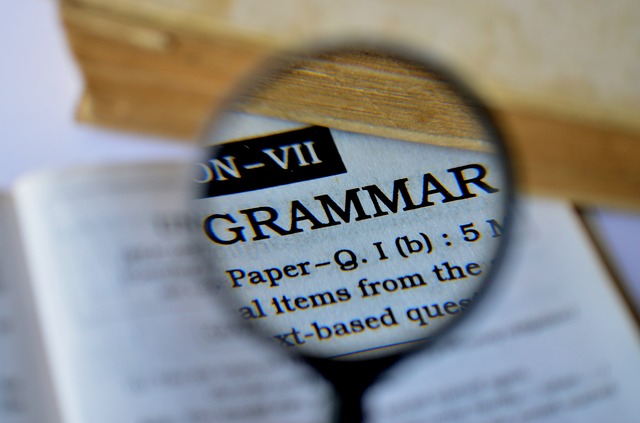Grammar Spotlight
 The English Grammar Profile (EGP) is a sister resource to the English Vocabulary Profile, and has been put together by Anne O'Keeffe (Limerick University) and Geraldine Mark, the co-authors, along with Ron Carter and Mike McCarthy, of English Grammar Today (Cambridge University Press). Mark and O'Keeffe investigated the extensive data in the Cambridge Learner Corpus to establish when learners begin to get to grips with different linguistic structures.
The English Grammar Profile (EGP) is a sister resource to the English Vocabulary Profile, and has been put together by Anne O'Keeffe (Limerick University) and Geraldine Mark, the co-authors, along with Ron Carter and Mike McCarthy, of English Grammar Today (Cambridge University Press). Mark and O'Keeffe investigated the extensive data in the Cambridge Learner Corpus to establish when learners begin to get to grips with different linguistic structures.
A series of insights from their research will be posted on this page, each one putting the spotlight on an interesting aspect of learner grammar development. Please note that all of the learner examples come from the Cambridge Learner Corpus, a 55-million word electronic collection of written learner data. The examination and the candidate’s first language are given in brackets after each learner example.
See the latest Grammar Spotlight entry below. Scroll right down to the bottom of this page to browse through previous entries.
Not surprisingly, the first coordinating conjunctions that learners use are and, but and or. These are used by A1 learners and used with great frequency by A2 learners. As is the case with native speakers, and is the most commonly used coordinating conjunction.
And, but and or are used by learners to connect nouns, adjectives and phrases.
 I like chicken and rice. (Skills for Life; Kurdish)
I like chicken and rice. (Skills for Life; Kurdish)
 My street is quiet and friendly. (Skills for Life; Polish)
My street is quiet and friendly. (Skills for Life; Polish)
 My house is small but very nice. (Skills for Life; Pashto)
My house is small but very nice. (Skills for Life; Pashto)
And, but and or also appear in lists.
 I go to college every Tuesday, Thursday and Friday morning. (Skills for Life; French)
I go to college every Tuesday, Thursday and Friday morning. (Skills for Life; French)
 I like to eat steak, vegetables, potatoes or rice. (Skills for Life; Polish)
I like to eat steak, vegetables, potatoes or rice. (Skills for Life; Polish)
 I really like my English course because there are very good students from other countries, for example from Italy, Portugal, China and India. (Skills for Life; Slovak)
I really like my English course because there are very good students from other countries, for example from Italy, Portugal, China and India. (Skills for Life; Slovak)
A1 and A2 learners can use but to add an unexpected contrast.
 I really like my home. It is very small but it is very easy to clean. (Skills for Life; Urdu)
I really like my home. It is very small but it is very easy to clean. (Skills for Life; Urdu)
 I like my home. It’s small but so comfortable, and the decoration is beautiful. (Skills for Life; Portuguese)
I like my home. It’s small but so comfortable, and the decoration is beautiful. (Skills for Life; Portuguese)
These single word conjunctions are also used to combine clauses.
 There are lots of shops in the town and the town is only five minutes away. (Skills for Life; Urdu)
There are lots of shops in the town and the town is only five minutes away. (Skills for Life; Urdu)
 We love to go to the cinema or just sit together and have a laugh. (Skills for Life; Portuguese)
We love to go to the cinema or just sit together and have a laugh. (Skills for Life; Portuguese)
 I have visited a lot of places, but the best place is Thailand. (Skills for Life; Slovak)
I have visited a lot of places, but the best place is Thailand. (Skills for Life; Slovak)
Perhaps contrary to the desired outcomes set by some teachers, and, but and or are frequently used to start a sentence. Yet, this usage is also commonly seen in examples of both spoken and written English produced by native speakers.
 I go shopping on Ladypool Road. Or sometimes I go to my local shop. (Skills for Life; Panjabi)
I go shopping on Ladypool Road. Or sometimes I go to my local shop. (Skills for Life; Panjabi)
 I am from Estonia. Estonia is a small country near the Baltic Sea. But now I live in Dorchester, because I work here. (Skills for Life; Russian)
I am from Estonia. Estonia is a small country near the Baltic Sea. But now I live in Dorchester, because I work here. (Skills for Life; Russian)
 I like it because there are lots of shops, it is not too busy and there is lots of parking. And I like my home because it’s not too big and it’s a very nice flat. (Skills for Life; Tamil)
I like it because there are lots of shops, it is not too busy and there is lots of parking. And I like my home because it’s not too big and it’s a very nice flat. (Skills for Life; Tamil)
So, by the A2 level, learners can use coordinating conjunctions in a variety of ways. While mistakes still occur (commonly in the form of a missing conjunction), a significant number of learners show a level of confidence with using and, but and or that supports their movement toward the use of a wider variety of coordinating conjunctions at the B1 and B2 level.






